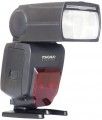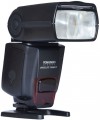Camera compatibility
Camera models that the flash can work with. Note that this parameter is usually indicated in the characteristics very approximately — only camera manufacturers are named, but there is no talk of models as such. Therefore, before purchasing a flash, it makes sense to separately clarify whether it will work normally with your camera — for example, on the manufacturer's website or thematic forums. This is especially true for devices from third-party manufacturers — for such models, the likelihood of problems is somewhat higher than for “native” flash cameras. At the same time, devices from the same company usually have the same requirements for connecting flashes, and therefore this parameter is with a fairly high degree of accuracy allows you to evaluate compatibility.
If the specifications of the flash indicate compatibility with several brands of cameras, this usually means that this model is available in several variations, each of which is designed for a different manufacturer.
It is worth noting that the "non-native" camera and flash may be quite compatible and work fine in most shooting modes. Nevertheless, support for TTL (see below) and a number of other specific functions in this case is usually out of the question, and in general, the reliability and efficiency of this combination is lower than that of a camera with a "native" flash. Therefore, it is better to choose all the same accessories with directly claimed compatibility.
Of t
...he compatible cameras currently in use: Canon, Fuji, Leica, Nikon, Olympus, Panasonic, Pentax, Samsung, Sigma, Sony.Guide number
The guide number is the main characteristic that describes the power of the light pulse of the flash. It is described as the maximum distance (in metres) at which, at ISO 100 and f/1 lens speed (aperture 1), a flash is able to illuminate an "average" subject sufficiently for a normal exposure; in other words, at what distance from the flash it will be possible to normally shoot the scene at the specified ISO and aperture.
There are formulas by which, knowing the guide number, you can derive the practical shooting distance for each specific value of sensitivity and aperture. The simplest formula used to calculate the distance at ISO 100 is: S=N/f, where S is the distance, N is the guide number, f is the aperture value. For example, for a guide number of 56 and an f/2.8 lens, this distance would be 56/2.8 = 20 m. Increasing or decreasing sensitivity by a factor of 2 would increase or decrease the specified distance by approximately 1.4 times, respectively. If you need to calculate the distance as accurately as possible, you should refer to more detailed formulas that can be found in specialized sources.
Separately, it is worth noting that the leading numbers of flashes, usually, are indicated by manufacturers for specific focal lengths of lenses. This is due to the fact that the shorter the focal length and, accordingly, the wider the viewing angle, the more light is needed to illuminate the scene being shot and the more powerful the flash pulse should b...e (at the same distance). Therefore, when choosing by the guide number, it makes sense to pay attention to the focal length indicated by the manufacturer and select a model with a power reserve — especially since guide numbers are often prescribed for rather “long-range” lenses (with a focal length of about 80-100 mm in equiv. 35 mm).
Pulse duration
The duration of the pulse of light provided by the flash. This indicator can range from thousandths to hundred thousandths of a second; it is usually expressed as a fractional number with a unit in the numerator, such as 1/880 s. The human eye does not notice the difference, but in some shooting modes it can become critical. For example, to capture fast-moving scenes (such as splashing water, the flight of an insect, or the movement of machine parts) you need to choose a flash with the shortest flash duration possible — otherwise the image may be blurry.
The longest pulse duration in modern photoflashes is about 1/800 s; the minimum value can reach 1/30,000 s or even less.
TTL
Flash units with TTL support. TTL is an abbreviation for "through the lens", i.e. "through the lens"; this is the name of the method of measuring exposure by the amount of light that passes directly through the camera lens.
In digital photography, TTL works like a pre-flash: before the main exposure, the flash fires one or more test flashes. The amount of light coming from the object being filmed is measured by special sensors, based on these data, the control electronics sets the necessary shooting parameters, after which the actual exposure takes place. This allows you to fine-tune the camera and get an image of optimal quality. The interval between the test and operating pulses is so small that it may not be visible to the naked eye at all (especially when the flash is synchronized with the front curtain or with a slow shutter speed).
Many modern camera manufacturers have their own developments and varieties of TTL technology, respectively, differing in name: for example, Canon has E-TTL and E-TTL II, Nikon has D-TTL (in early models) and i-TTL (in later ones) , Pentax has P-TTL, etc. Support for one or another variety is directly related to the compatibility of the flash with cameras (see above), and different formats are usually not compatible with each other.
Beam angle
The angle at which the main beam of light from the flash diverges. This parameter is not expressed directly, in degrees, but in terms of the focal lengths of the corresponding lenses, in millimetres: for example, a beam angle of 105 mm corresponds to the angle of view of a lens with the same focal length (35 mm equivalent). This makes it easy to select a flash for specific optics, so that it most effectively illuminates all the space in the frame. And the most advanced modern flashes can have a variable dispersion angle, allowing you to adjust them to different shooting features; this feature is especially useful when using zoom lenses. Changing the angle of dispersion is carried out by a movable lens installed in the flash head, it can be carried out both automatically and manually (for more details, see "Functions and Capabilities").
Features
—
Autofocus assist light. The presence of an auxiliary illumination function in the flash for the camera's autofocus system. Modern cameras in the vast majority use the so-called passive autofocus systems, which have one serious drawback: very low efficiency in low light and/or low contrast of the subject being photographed. Autofocus assist light is designed to solve this problem: before focusing, the scene is illuminated by a separate lamp, located, in this case, directly in the flash body. This ensures a sufficient amount of light for normal autofocus operation. Most often, the backlight lamps give off light of a characteristic reddish hue, but some advanced models use infrared illumination - invisible to the eye, but perceived by the camera. In addition, backlight systems can use a special light pattern instead of a solid beam, which further simplifies the task of autofocus systems. In any case, the presence of this function is especially important given that the flash is often used as a light source in low light.
— On-camera control. The ability to change the flash settings using the controls of the camera to which it is connected. In some cases (for example, with a wireless connection), this is much more convenient than switching attention from the camera to the flash.
—
Automatic zoom. The ability to automatically change the flash light scattering angle. For the scattering angle
..., see the corresponding point above, but here we note that this function provides synchronization between the flash and the lens: when the focal length of the lens changes, the scattering angle automatically changes. This ensures the most effective illumination of the scene and at the same time saves you from having to manually readjust the flash each time to the changed viewing angle.
— Manual zoom. The ability to change the flash spread angle (see "Light spread angle") manually. This function expands the possibilities for "fine" adjustment of operating parameters and allows you to set parameters that are not available with automatic zoom (see above). In addition, it will be useful if you have to use several fixed lenses with different focal lengths - the flash can be easily adjusted for each of them.
— Operation in master mode. The ability to operate the flash as a master for a system of several flashes. The entire system is controlled via the master flash, the parameters of the slave flashes are set, and the command to fire is given (note that the master flash itself may not give a pulse at all). If you plan to shoot using a system of several flashes, you will definitely need a model with this function — without it, creating a system is impossible. Of course, the master and slave flashes must be mutually compatible; this point should be clarified separately.
— Slave mode. The ability to operate the flash as a slave in a system of several flashes. In this mode, the device is connected to the master flash and is triggered by a command from it. For more information on flash systems, see "Master mode operation" above.
— Radio synchronizer. A device designed for wireless control of a flash or a set of flashes (if each of them has its own receiver). Usually it is a separate module installed in a hot shoe; upon a command to trigger, this module sends a radio signal to all receivers tuned to it, ensuring synchronous triggering of the flashes. At the same time, some models of lamps with this function are capable of receiving via radio not only the trigger signal, but also the operating parameters (primarily the duration and power of the pulse).
